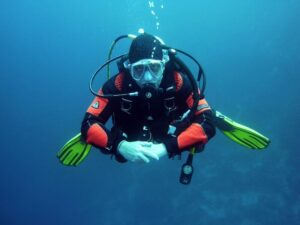A wetsuit is like your second skin. It is your companion when diving so that you can adapt perfectly to the marine environment. A wetsuit that does not fit you properly will affect your experience tremendously in a negative way.
Key Takeaways:
- Learn how you choose a wetsuit carefully to avoid problems in advance
- What wetsuits sizes you can pick,depending on your weight, height, gender, age, water sports, etc. and how the measurements for these sizes vary from manufacturer to manufacturer
- The Thickness of the material is crucial
Although it can be a challenge to choose the right wetsuit in the right size and thickness (especially for those who are buying a wetsuit for the first time), it is advisable to take some time to do so, especially if you are buying your first wetsuit.
In this wetsuit size guide you will find all the necessary information you need to know to consider and make the right choice. You’ll also benefit from an accurate wetsuit sizing chart that will help you find the right size for your wetsuit.
„Your wetsuit has to feel like the perfect fit, otherwise it is not your size, here you find out how to find your wetsuit size “
What wetsuit sizes are available?
The wetsuits you can find come in different sizes between XXS and XXXL, depending on your weight, height, gender, age, water sports, etc. They fit tighter than your normal clothes. Luckily in recent years, intermediate sizes, which take in consideration different physic structures, have also become more present.
A typical example is the size MS. MS is basically a size M, but for persons with a rather short and wider body structure. Through this intermediate sizes it is only a matter of trying to find the perfect size.
Usual Wetsuits sizes are:
- XXS- Extra extra small
- XS- Extra Small
- S- Small
- M- Medium
- L- Large
- XL- Extra large
- XXL- Double Extra Large
- XXXL- Triple Extra Extra Large
You should select the size based on your physique and body measurements. The measurements for each size vary from manufacturer to manufacturer.
What wetsuit size do I need?
Before buying a wetsuit, you should ask yourself some relevant questions like:
- What is the type of wetsuit available in the market?
- Which wetsuit is suitable considering the water temperature?
- What size should I buy for maximum comfort?
- What should be the thickness of the neoprene fabric?
There are various types of wetsuits available offline and online- a full suit, spring suit, wetsuit jacket, wetsuit vest, wetsuit jacket, short wetsuit, long wetsuit, short arm steamer, etc. You can easily get lost if you do not have a sufficient overview of your usage behavior and environment.
How should a wetsuit fit?
A wetsuit is made of Neoprene which is a stretchy material. Therefore the wetsuit must be closely knitted and have modest tightness for the ideal fit. Be aware of it when you try it on.
The wetsuit tends to get broader gradually after wearing it several times.
When you are trying wetsuits take care of the following details:
- You should ensure that the wetsuit is tight but does not cause any breathing problems.
- Only the creases beneath the armpit should be visible to ensure flexibility while moving hands and legs.
- The wetsuit should also fit snugly around the ankles and your wrists to not allow any water to enter.
- There should be little space on the lower back to avoid water accumulation. If you feel too much air on the lower back, your wetsuit is the wrong size.
- Make sure to test sufficiently movements like turning, stretching and bending
Wetsuit Size chart
Manufacturers make wetsuits of various sizes and designate them with different letters. Refer to the wetsuit size chart of that specific brand to determine the correct size.
Despite the fact that the companies use the same letters to define the ranges, the sizes vary from company to company. For example, the M size of one brand might be equivalent to the L size of other brands.
Wetsuit size chart according to physique:
| Normal | Wide and short | Thin and tall |
| S | XS | ST |
| M, ML | MS, MLS | MT, MLT |
| L | LS | LT |
| XL | XLS | XLT |
| XXL | XXXL |
Below is the wetsuit size chart of one of the most popular brands, Xcel:
| Size | Height | Weight | Chest | Waist |
| XS | 5’7 to 5’9 | 125 to 140 | 34.5 to 36.5 | 28 to 30 |
| S | 5’8 to 5’10 | 135 to 155 | 36.5 to 38.5 | 29 to 31 |
| ST | 6’0 to 6’2 | 145 to 165 | 36.5 to 38.5 | 29 to 31 |
| MS | 5’6 to 5’8 | 140 to 160 | 38.5 to 40.5 | 30.5 to 32.5 |
| M | 5’9 to 5’11 | 150 to 170 | 38.5 to 40.5 | 30.5 to 32.5 |
| ML | 5’9 to 5’11 | 165 to 180 | 39 to 41 | 32 to 34 |
| MT | 6’1 to 3’3 | 160 to 180 | 38.5 to 40.5 | 30.5 to 32.5 |
| LS | 5’7 to 5’9 | 160 to 180 | 40.5 to 42.5 | 32.5 to 34.5 |
| L | 5’10 to 6’0 | 170 to 190 | 40.5 to 42.5 | 32.5 to 34.5 |
| LT | 6’2 to 6’4 | 180 to 200 | 40.5 to 42.5 | 32.5 to 34.5 |
| XLS | 5’8 to 5’10 | 180 to 200 | 40.5 to 42.5 | 34.5 to 36.5 |
| XL | 5’11 to 6’1 | 190 to 210 | 42.5 to 44.5 | 34.5 to 36.5 |
| XLT | 6’3 to 6’5 | 200 to 220 | 42.5 to 44.5 | 34.5 to 36.5 |
| XXL | 6’0 to 6’2 | 210 to 230 | 45.5 to 46.5 | 36.5 to 38.5 |
Some companies also have a separate wetsuit size chart for men and women.
The thickness of the wetsuit
The choice of wetsuit is crucial for maintaining body temperature while in the water. So use your own discretion when it comes to temperature recommendations. Use a thicker suit if you are less cold tolerant or want a little more comfort.
However, keep in mind that a thicker suit is less flexible. The following factors must be considered when choosing the right thickness of the wetsuit:
- Water sports you will be doing
- Water temperature
- Wind speed
- Activity level (Rigour)
- Air temperature
- Your sensitivity to getting cold
You must consider buying a thicker wetsuit:
- If you get cold easily
- For cold temperature
- More wind
- An activity with less movement
However, you should avoid buying a thick wetsuit if you want to do water surfing with high intensity. Otherwise, you might get too hot and get tired very quickly. If you need recommendations, you can take a look at this wetsuit temperature chart:
| Water tempearture(Fahrenheit) | Wetsuit Thickness | Recommended wetsuit type (and accessories) | Seal type |
| Below 42 | 6/5 mm | Full suit + Boots + Gloves + Hood | Sealed and taped |
| 43 to 52 | 5/4 mm | Full suit + Boots + Gloves + Hood | Sealed and taped |
| 52 to 58 | 4/3 mm | Full suit + Boots + Gloves + Hood | Sealed and taped |
| 58 to 63 | 3/2 mm | Full suit + Boots + Gloves + Hood | Sealed |
| 62 to 68 | 0.5 mm to 2 mm | Springsuit/ Fullsuit | Flatlock |
| 65 to 75 | Top / Shorty | Flatlock | |
| Above 75 | Rashguard for skin and sun protection | Flatlock |
For the perfect wetsuit size: fit at the wrists and ankles
The wetsuit should fit tightly, so that water can not penetrate into the suit without dripping on the wrists and ankles. This deteriorates the quality of the fabric and causes discomfort during movement and stretching.
You can use foot loops to prevent water from entering your body. It also provides you with optimal support while windsurfing.
- It is padded and covered by neoprene material which prevents pressure points.
- It provides comfort, flexibility, and stability for surfing fun.
- The straps at the back of the board cover your feet when sailing in the stronger winds.
- The fasteners allow you to adjust according to your foot size.
Make sure that the wetsuit is not too long or too loose. If there is extra fabric in the torso area, water will settle there and you will soon shiver.
Water sports experts recommend not wearing anything under your wetsuit for maximum efficiency, comfort and warmth. Experts recommend that your body and wetsuit should either be wet or completely dry – unless you are wearing a wetsuit or skin-tight clothing that facilitates the suit’s glide.
Body measurements according to the wetsuits chart
Shorts or pants:
Measure the waist size
Top:
- The chest size is important. It is a little bit tricky to take an accurate chest measure. Ask for help of someone to do it correctly.
- Wrap the fabric measurement tape around the broadest portion of the chest.
Gloves:
- Measure around your palm.
- Buy a smaller size to avoid the risk of slipping down while doing water sports.
Boots
Note down the size of shoes or slippers you wear regularly.
General recommendations
- Size– Always buy one size larger so that it is comfortable to wear (not a smaller size)
- Length– It is ok if the suit is longer. But it should not be too short.
- If you are buying a wetsuit for the first time, measure your current size of clothes. Next, go through the wetsuit chart provided by the brand and compare it with your body measurements to determine the ideal fit.
- It should be tight on the torso, neck, shoulders, knees, and legs but comfortable to wear simultaneously.
- Wrinkles (creases) should be visible except under the armpits.
- Experiment with the fit of the wetsuit through various motions such as turning, bending, stretching, and paddling.
- The protectors should fit appropriately and firmly on the knees.
- Since wetsuit boots fit tighter than the regular size, you should round down to the nearest size.
- When you are confused between two sizes, always go with the larger one.
Fit of the wetsuit
It is very important to wear a wetsuit that fits properly. Each wetsuit has a unique fit and cut. Therefore, the sizes of different brands may differ from each other. The size you feel fits in the chart may not fit your body type.
Bend, stretch and wave your arms when trying on a wetsuit at a surf store to get the best fit. Pay special attention to the knees, underarms, crotch, neck and ankles.
Do you still have problems with the fit after trying on wetsuits in different sizes? Then there is an alternative. The best way to ensure the right fit is to buy a custom wetsuit. For this, you need to provide a comprehensive set of your specific measurements.
The Do’s and Don’ts of proper wetsuit care
Taking proper care of the wetsuit after buying it is necessary to ensure that it lasts longer. Regular care will extend its life and save you money in the long term. Here are some tips for the long-term durability of a wetsuit.
- Dry your wetsuit first. Once the wetsuit is dry from the inside, turn it to let it dry from the outside.
- Do not fold the wetsuit to avoid wrinkles on the neoprene material.
- Don’t wash your wetsuit in the washing machine or dry it with a dryer. Also, do not use bleach, detergent, stain remover, fabric softener, etc. Do not iron it. Use mild liquid soap to wash it.
- Do not rinse your wetsuit in hot water. Instead, use cold or lukewarm water. Also, don’t leave it in the sun. UV radiation will deteriorate the fabric quality.
- Dry your wetsuit on a suitable hanger in the fresh air to avoid foul smell.
Wetsuit Accessories
Occasionally you may need something more to brave the cold. Buying a heated vest or titanium vest, boots, gloves, neoprene socks and a wetsuit hood can help against the cold. It should be noted that each person feels the cold differently.
Neoprene Gloves- They provide maximum thermal protection to keep your hands warm. It allows you to surf in the coldest condition.
Neoprene booties- They will keep your feet warm even in the most frigid of waters. Also, they will keep you safe from sharp rocks.
Hoods- It helps when your head gets cold in the water quickly.
Wetsuit socks- Many people find it much more comfortable to wear socks inside the wetsuit boots.
Conclusion: Fit is very important for your wetsuit
Make sure that the wetsuit should fit tightly, so that water can not penetrate into the suit without dripping on the wrists and ankles. Bend, stretch and wave your arms when trying on a wetsuit at a surf store to get the best fit.
Correct size is equally important as the quality and thickness of the wetsuit.Wetsuits act as an insulator and trap the water between the suit and skin to keep the body warm.
A wetsuit of the right size will ensure flexibility and comfort while performing water sports, whether swimming, surfing, waterskiing, scuba diving, etc. You should not compromise on the quality by buying a cheap wetsuit to protect yourself from the cold waves while surfing.







